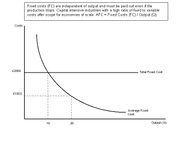User:Kvenkatesh/short run cost/
In this note we consider production costs in the short run, in particular the difference between fixed and variable costs and the relationships between marginal and average costs. In the short run, because at least one factor of production is fixed, output can be increased only by adding more variable factors. Hence we consider both fixed and variable costs Fixed costs Fixed costs are business expenses that do not vary directly with the level of output i.e. they are treated as independent of the level of production. Examples of fixed costs include the rental costs of buildings; the costs of leasing or purchasing capital equipment such as plant and machinery; the annual business rate charged by local authorities; the costs of full-time contracted salaried staff; the costs of meeting interest payments on loans; the depreciation of fixed capital (due solely to age) and also the costs of business insurance.
Fixed costs are the overhead costs of a business. They are important in markets where the fixed costs are high but the variable costs associated with making a small increase in output are relatively low. We will come back to this when we consider economies of scale. • Total fixed costs (TFC) remain constant as output increases • Average fixed cost (AFC) = total fixed costs divided by output Average fixed costs must fall continuously as output increases because total fixed costs are being spread over a higher level of production. In industries where the ratio of fixed to variable costs is extremely high, there is great scope for a business to exploit lower fixed costs per unit if it can produce at a big enough size. Consider the new Sony portable play station. The fixed costs of developing the product are enormous, but these costs can be divided by millions of individual units sold across the world. A change in fixed costs has no effect on marginal costs. Marginal costs relate only to variable costs! Variable Costs Variable costs are costs that vary directly with output. Examples of variable costs include the costs of intermediate raw materials and other components, the wages of part-time staff or employees paid by the hour, the costs of electricity and gas and the depreciation of capital inputs due to wear and tear. Average variable cost (AVC) = total variable costs (TVC) /output (Q)
